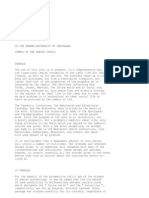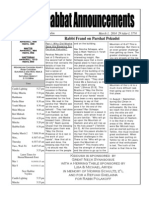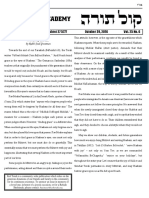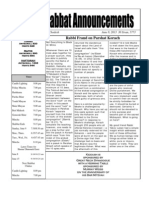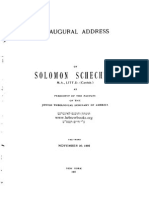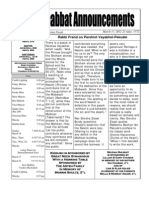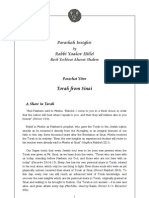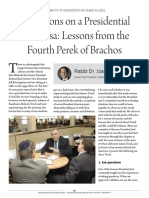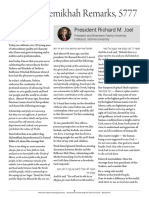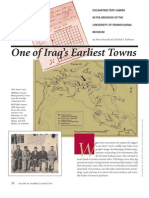Likutei Ohr: A Publication of YULA Boys High School
Likutei Ohr: A Publication of YULA Boys High School
Uploaded by
outdash2Copyright:
Available Formats
Likutei Ohr: A Publication of YULA Boys High School
Likutei Ohr: A Publication of YULA Boys High School
Uploaded by
outdash2Original Title
Copyright
Available Formats
Share this document
Did you find this document useful?
Is this content inappropriate?
Copyright:
Available Formats
Likutei Ohr: A Publication of YULA Boys High School
Likutei Ohr: A Publication of YULA Boys High School
Uploaded by
outdash2Copyright:
Available Formats
,In Memory of Mr. Max Glass -.$% ('/ "0&1 !
( %#230 &'$01 +*&
0n Memory of Mr. Jack Gindi !"#" $"%&' !( $"%&' ()*% +*&
Likutei Ohr
Volume III : Issue III
!di"r-in-Chief: #riel Amse$em 15 %enior Edi"r: !itan Meisels 15 &ichael Somekh 15 &anaging Edi"rs: Jack Levkowitz 17 !itan Tennenbaum 17 'ayout Edi"r: (air Fax 14 &arke)ng: (osef Hier 16 #sher Naghi 14 *is+ibu"rs: &itche$ Silberberg 14 &ichael Lazovsky 14 Jordan Lustman 15 %ta, Advisor: -abbi Arye Su.i/
The Pamphlet of Light
Parshat Pikudei
A publication of YULA Boys High School!
3$' %4$)%&
Rabbi Joseph Schrieber
Moshe and the Mishkan
And they brought the Mishkan to Moshe !"# $% &'"#! (% )%*+*) (Shemot 39:33). On the above Pasuk, Rashi explains that the Mishkan was brought to Moshe because they were unable to erect it, and since Moshe did no work on the construction of the Mishkan, HaKadosh Baruch Hu left the task of raising it to him [Moshe], for no man was able to erect it because of the weight of the beams. However, Moshe was able to set them upright. One of the most important aspects of the Mishkan was the power that it had to unify Bnei Yisrael. On holidays and at various times throughout the year, all of the tribes and people who were scattered and separated would gather in the Mishkan and be united as one great nation. Similarly, in last weeks Parsha, we are told he [Moshe] made the Briach HaTichon, the middle bar, to extend within the beams from end to end (Shemot 36:33). This Briach HaTichon was symbolic of how the Mishkan was able to bring together and join the Jewish People from one end of the world to the other. Clearly, the Torah is trying to relay the message that the Mishkan is a place for Am Yisrael to come together as one nation. It is interesting to note that even though the Mishkan was a great unifier, there was no one man or any one group of men who were able to erect it and raise it upon its completion. Even the skilled laborers who were divinely inspired and worked tirelessly to construct the Mishkan were unable to set it upright. As Rashi states, only Moshe was able to do so: Moshe was able to set them upright. This seems to contradict the recurring theme and focal axiom of unity among Bnei Yisrael that appears throughout the story of the Mishkan. This deviation from the Parshas principal lesson requires explanation. Why was it that only Moshe was able to erect the Mishkan? Rav Zalman Sorotzkin ztl, in Oznaim LaTorah, explains that Moshe was able to erect the Mishkan because he was the giver of the Torah. This characteristic was symbolic of the fact that the only true unifier for Bnei Yisrael is our Torah. As Rav Saadiah Gaon has stated multiple times, our nation is not a nation without our holy Torah! The fact that Moshe was able to set them upright teaches us this important lesson. Moshes ability to erect the Mishkan also demonstrates for us the power of our spiritual leaders, our portals of Torah. Without our Rebbis, Morim, and Morot, the generations of Jews who have come and gone would have never been able to overcome the forces of assimilation and acculturation. We must remember that only through Torah will we be united as we have throughout our history. This means that we must reacquire the desire for learning that used to define Am Yisrael because the study of Torah and finding its beauty is what really brings us closer to the Ribbono Shel Olam, which then brings us closer to each other. Of course, our nation must find goals that can and will unite us, but we must never forget that only through Moshe, the leaders of each generation, and the learning the Torah that Hashem gave us will we be able to set them upright.
The Flame of Our Ancestors
When one looks truly at the good side of everyone, others come to love him very naturally... - Rabbi Avraham Yitzchak Kook
1e2$ah Gems
(osef Petlak 17
Last week, we learned about the importance of showing the proper respect and reverence in a Bet Knesset. This week we will discuss the specific Halachot that pertain to a persons behavior in a Bet Knesset. There are numerous Halachot regarding the proper conduct once inside a Shul. Many of these Halachot pertain to the way one enters the Shul. For example, one may not use a Shul as a short cut or as a shelter from a rainstorm. If one absolutely must enter a Bet Knesset for a purpose not related to learning or Davening, then he should sit down and recite a verse or learn a little bit of Torah. We learn these Halachot from the way in which people would conduct themselves in the Bet HaMikdash where all of these Halachot applied. These Halachot are extremely important, and we must do our best to make sure we incorporate them into our daily prayer routine.
The Strength of a Sin
Pinchas Gamzo 17
At the end of this weeks Parsha, Parshat Pikudei, the Torah talks about Moshes final steps in building the Mishkan. One of the last procedures he accomplishes is the placing of the Luchot in the Aron. Then, Moshe places the poles of the Aron into their rings. This sequence of events poses a problem: In Parshat Terumah the Torah writes that the insertion of the poles happened before the placement of the Luchot; the order is reversed in Pikudei, which seems to suggest a contradiction between the two Parshiot. The solution to this inconsistency can be found in a Gemara in Messechet Yumah. The Gemara explains that the poles had to be put into the rings forcefully rather than just slipped in because the poles were thick at the ends and thin in the middle. In other words, once someone fit it through the ring, the pole would be stuck there for all eternity. However, this thinking is illogical: If the poles could be placed in the holes, then it should have been possible to take the poles out! The answer to this difficulty lies in the supernatural qualities of the Aron. The Aron was not an object that followed the obvious laws of nature or physics. When those that worked in the Mishkan came to fit the poles through the rings, the rings stretched out and allowed the poles to fit in easily. Yet, this was only done when they stuck the poles in, a deed that was considered a Mitzvah, but had they wanted to remove the poles then the miracle would not have occurred. Now we can solve the contradiction between the texts of Parshat Terumah and Parshat Pikudei. Parshat Terumah took place before the sin of the Golden Calf; at that time Klal Yisrael had not been tainted by the egregious sin. However, by Parshat Pikudei the Children of Israel had already done the Chet HaEgel. Before the Chet Hashem made everything about the Aron miraculous. That is why in Parshat Terumah, before they put the Luchot in the Aron, the rings would spread out; yet, in Parshat Pikudei, which was after the the sin of the calf, the rings would not spread out until the Luchot were already inside. The Luchot symbolically acted as a reminder to Am Yisrael of their terrible misdeed. It was a concrete object that told them nothing, not even a Mitzvah related to the miraculous Aron, would be the same as before the Chet. That is why the Luchot, the reminder, had to be in the Aron before any miracle could be preformed.
H a l a c h i c I l l u m i n at i o n From Rabbi nachum sauer
Cholent is a common item to have at Kiddush or a Shabbat meal nowadays, but where did this tasty custom all start? The Ohr Zarua mentioned Cholent by name in the mid-13th century. Etymologists have been looking into the origin of the word Cholent and have come up with a few hypotheses: One idea is that it descended from the Hebrew-Aramaic word Shelan, literally a food that rests overnight; another hypothesis is that the term comes from the word Shaluk, which means thoroughly cooked; yet, others say it is a combination of the French words Chaud (hot) and Lent (slow). Most Sefardim stick to the name Chamin, the title the Mishnah in Mesechet Shabbat gives to hot food eaten on the seventh day of the week. The origins of this dish lie in the words of the Baal HaMaor, Rav Zerachiah HaLevi from Gerona, who lived in the twelfth century. He writes that it is a Takanat Chachamim to enjoy Shabbat with a hot dish. He adds that one who does not do so is suspected of being a heretic. The reason behind this ruling was that the heterodox Karaim (Karaites), who denied the Rabbinic Mesorah, prohibited eating any hot food on Shabbat. Therefore, the Baal HaMaor explains that one who does not eat a hot dish on Shabbat is suspected of following the heretical interpretation of the Torah and not the interpretation of the Chachmei HaDorot, the great Rabbis of the generations. On the other hand, the Baal HaMaor assures that whoever does make sure to cook, heat up (before Shabbat), and eat a hot dish on the Shabbat will merit to see the end of days. This is surprisingly not a minority opinion as eating Cholent is considered a Mitzvah according to the Rema and a Minhag Yisrael according to the Mishneh Berurah.
Compiled By Jesse Hyman 16
Out of Order?
Nathan Silberberg 16
Betzalel, son of Uri, son of Hur, of the tribe of Judah, had made all that the Lord had commanded Moshe (Shemot 38:22). In this weeks Parsha, Parshat Pekudei, Rashi writes on the above verse that Moshe had told Betzalel to build the vessels of the Mishkan first before constructing the structure itself. However, this seems quite counterintuitive. After all, when building a home it is most reasonable to make the house first and then furnish it once the construction has already been completed. Betzalel followed this logic when making the Mishkan, Hashems house, and created the walls to protect the vessels from the elements before the vessels were themselves created. Ultimately, Moshe consented when Betzalel decided to change the order because Hashem had actually told Moshe to build the Mishkan before the vessels. Rabbi Levovoitz comments that this Rashi stresses the importance of doing things in proper order. The best way to achieve such an order is through clarifying and re-clarifying our priorities and responsibilities. Such organizational skills are such incredibly important and helpful tools that one must acquire and develop in order to accomplish and fulfill the potential that the Ribbono Shel Olam has given us. One must have a good grasp of his responsibilities in order to identify those that he must meet at this moment and those that he can accomplish at a later date. If we do not prioritize and organize our lives, we will never have enough time to do the things that we want and truly need to do. However, by prioritizing and making ourselves aware of the importance of our goals and aspirations, we will certainly accomplish our objectives. If this sounds like a daunting task, well, it is. Because organization is a lifestyle rather than a nice idea, people reject it out of laziness. Yet, keeping order can be made simple by a few short, easy tasks done every day. Maybe one should make a list of the various diurnal tasks and goals that need to be taken care of. Then, he could decide on a proper order in which to effectively execute those tasks. When we do this, we will be able to accomplish and fulfill our different missions in life just as Betzalel did when he fixed the order of the tasks to be accomplished in the building of the Mishkan.
(ULA Boys High School Nagel Family Campus 9760 W. Pico Blvd. Los Angeles, CA 90035 Tel: 310.203.3180
You might also like
- Anarcho Autism by Detroit Leprechaun2Document126 pagesAnarcho Autism by Detroit Leprechaun2ariaNo ratings yet
- Full Text of - The Jewish UtopiaDocument135 pagesFull Text of - The Jewish UtopiaFrancisco GUTIERREZNo ratings yet
- The Jewish Utopia Higger 1932Document101 pagesThe Jewish Utopia Higger 1932Maria Joseph K.100% (1)
- Lessons Learned From Conversion: Rabbi Zvi RommDocument5 pagesLessons Learned From Conversion: Rabbi Zvi Rommoutdash2No ratings yet
- Quizzes - Chapter 2 - Statement of Comprehensive IncomeDocument6 pagesQuizzes - Chapter 2 - Statement of Comprehensive IncomeAmie Jane Miranda80% (5)
- Chapter 11: Flexible Budgeting and The Management of Overhead and Support Activity CostsDocument37 pagesChapter 11: Flexible Budgeting and The Management of Overhead and Support Activity CostsSteph GonzagaNo ratings yet
- Likutei Ohr: A Publication of YULA Boys High SchoolDocument2 pagesLikutei Ohr: A Publication of YULA Boys High Schooloutdash2No ratings yet
- The Light Within Our Darkness: Chanukah: The Holiday of FaithDocument8 pagesThe Light Within Our Darkness: Chanukah: The Holiday of Faithoutdash2No ratings yet
- Shabbat Announcements March 1Document4 pagesShabbat Announcements March 1gnswebNo ratings yet
- Finding Grace: Parashat Bereishit Tishrei 27 5777 October 29, 2016 Vol. 25 No. 6Document4 pagesFinding Grace: Parashat Bereishit Tishrei 27 5777 October 29, 2016 Vol. 25 No. 6outdash2No ratings yet
- Likutei Ohr: A Publication ofDocument2 pagesLikutei Ohr: A Publication ofoutdash2No ratings yet
- Toronto TorahDocument4 pagesToronto Torahoutdash2No ratings yet
- Shabbat Announcements June 8Document4 pagesShabbat Announcements June 8gnswebNo ratings yet
- UntitledDocument24 pagesUntitledoutdashNo ratings yet
- Vol. Xii No. 14 - May 24, 2013Document12 pagesVol. Xii No. 14 - May 24, 2013Antonio da AlvaNo ratings yet
- The Eternal Message of The Urim and ThumimDocument4 pagesThe Eternal Message of The Urim and Thumimoutdash2No ratings yet
- The Importance of Peace at Heart: by Brian Chernigoff, 10th GradeDocument10 pagesThe Importance of Peace at Heart: by Brian Chernigoff, 10th Gradeoutdash2No ratings yet
- Non-Profit Prophet: by Eli Stahler, 12th GradeDocument8 pagesNon-Profit Prophet: by Eli Stahler, 12th Gradeoutdash2No ratings yet
- Serving Hashem With AuthenticityDocument5 pagesServing Hashem With Authenticityoutdash2No ratings yet
- Likutei Ohr: A Publication of YULA Boys High SchoolDocument2 pagesLikutei Ohr: A Publication of YULA Boys High Schooloutdash2No ratings yet
- Inaugural Address of Solomon SchechterDocument32 pagesInaugural Address of Solomon SchechterdeblazeNo ratings yet
- Likutei Ohr: Parshat TrumahDocument2 pagesLikutei Ohr: Parshat Trumahoutdash2No ratings yet
- Teaching The Mesorah: Avodah Namely, He Is Both A Posek (Halachic Decisor) and An Educator For The EntireDocument5 pagesTeaching The Mesorah: Avodah Namely, He Is Both A Posek (Halachic Decisor) and An Educator For The Entireoutdash2No ratings yet
- Being Wise of Heart: Volume XIII - Issue 11 The DRS Weekly Torah PublicationDocument8 pagesBeing Wise of Heart: Volume XIII - Issue 11 The DRS Weekly Torah Publicationoutdash2No ratings yet
- Emor 4:7:23Document7 pagesEmor 4:7:23Kenneth LickerNo ratings yet
- Don't Outsmart The Torah: by Eitan Lipsky, 12th GradeDocument6 pagesDon't Outsmart The Torah: by Eitan Lipsky, 12th Gradeoutdash2No ratings yet
- From the Guardian's Vineyard on Sefer B'Reshith : (The Book of Genesis)From EverandFrom the Guardian's Vineyard on Sefer B'Reshith : (The Book of Genesis)No ratings yet
- Likutei Ohr: A Publication of YULA Boys High SchoolDocument2 pagesLikutei Ohr: A Publication of YULA Boys High Schooloutdash2No ratings yet
- Toronto TorahDocument4 pagesToronto Torahoutdash2No ratings yet
- Higger - The Jewish Utopia Authentic Zionist Mein Kampf 1932 PDFDocument135 pagesHigger - The Jewish Utopia Authentic Zionist Mein Kampf 1932 PDFJacobNo ratings yet
- Rov LeadershipDocument11 pagesRov LeadershipTechRavNo ratings yet
- Mi'Mizrach Shemesh VayakhelDocument4 pagesMi'Mizrach Shemesh VayakhelAri Bar-ShainNo ratings yet
- Torah: The Source of LifeDocument4 pagesTorah: The Source of Lifeoutdash2No ratings yet
- Likutei Ohr: A Publication of YULA Boys High SchoolDocument2 pagesLikutei Ohr: A Publication of YULA Boys High Schooloutdash2No ratings yet
- From The Wellsprings Shavuos 5783 1 0Document10 pagesFrom The Wellsprings Shavuos 5783 1 0Yehosef ShapiroNo ratings yet
- Answering The Call, in Life and LeadershipDocument5 pagesAnswering The Call, in Life and Leadershipoutdash2No ratings yet
- Toronto TorahDocument4 pagesToronto Torahoutdash2No ratings yet
- To Contemplate The Holy: 25 Adar I, 5776/march 5, 2016 Parshat Vayakhel/Shekalim Vol. 7 Num. 26Document4 pagesTo Contemplate The Holy: 25 Adar I, 5776/march 5, 2016 Parshat Vayakhel/Shekalim Vol. 7 Num. 26outdash2No ratings yet
- Vayakhel: The Connection Between Mishkan and ShabbosDocument6 pagesVayakhel: The Connection Between Mishkan and Shabbosoutdash2No ratings yet
- UntitledDocument2 pagesUntitledoutdash2No ratings yet
- To Contemplate The Holy: 25 Adar I, 5776/march 5, 2016 Parshat Vayakhel Vol. 7 Num. 26Document4 pagesTo Contemplate The Holy: 25 Adar I, 5776/march 5, 2016 Parshat Vayakhel Vol. 7 Num. 26outdash2No ratings yet
- Parashat KorachDocument3 pagesParashat Korachoutdash2No ratings yet
- Featured Articles Weekly ColumnsDocument40 pagesFeatured Articles Weekly ColumnsB. MerkurNo ratings yet
- Likutei Ohr: A Publication of YULA Boys High SchoolDocument2 pagesLikutei Ohr: A Publication of YULA Boys High Schooloutdash2No ratings yet
- Kitzur Shul'Han ArujDocument357 pagesKitzur Shul'Han ArujEdiciones Yojéved100% (3)
- Likutei Ohr: Parshat NoachDocument2 pagesLikutei Ohr: Parshat Noachoutdash2No ratings yet
- Mutual Respect: by Ariel Sacknovitz, Director of Production, 12th GradeDocument8 pagesMutual Respect: by Ariel Sacknovitz, Director of Production, 12th Gradeoutdash2No ratings yet
- The+Jewish+Utopia+ +Michael+Higger+ +1932Document173 pagesThe+Jewish+Utopia+ +Michael+Higger+ +1932Mauricio Souza LimaNo ratings yet
- Daniel C. Matt - The Zohar (The Zohar - Pritzker Edition), Vol 5 - Exodus. 5-Stanford University Press (2019)Document1,373 pagesDaniel C. Matt - The Zohar (The Zohar - Pritzker Edition), Vol 5 - Exodus. 5-Stanford University Press (2019)Swetta Agarrwal100% (1)
- The Copper Laver: The Women's Vessel: RashiDocument4 pagesThe Copper Laver: The Women's Vessel: Rashioutdash2No ratings yet
- The Teachings of The Rebbe 5718 Vol 2Document500 pagesThe Teachings of The Rebbe 5718 Vol 2Amanuel Ukbayohannes DestaNo ratings yet
- Beha'alotkha - TransfigurationDocument16 pagesBeha'alotkha - Transfigurationafeioroberta85No ratings yet
- Learning Torah All over Again?: The Newest Look at the Oldest BookFrom EverandLearning Torah All over Again?: The Newest Look at the Oldest BookNo ratings yet
- Where Is Ein RogelDocument5 pagesWhere Is Ein RogelmpoxNo ratings yet
- March 17 Shabbat AnnouncementsDocument4 pagesMarch 17 Shabbat AnnouncementsgnswebNo ratings yet
- Parshas Parah and Why We Read It: by Ariel Sacknovitz, 11th GradeDocument6 pagesParshas Parah and Why We Read It: by Ariel Sacknovitz, 11th Gradeoutdash2No ratings yet
- Details Count: Parashat Naso Sivan 12 5774 May 30, 2015 Vol. 24 No. 32Document4 pagesDetails Count: Parashat Naso Sivan 12 5774 May 30, 2015 Vol. 24 No. 32outdash2No ratings yet
- Torah From SinaiDocument13 pagesTorah From SinaiHarav Michael Elkohen100% (2)
- UntitledDocument20 pagesUntitledoutdash2No ratings yet
- Ki TisaDocument6 pagesKi Tisagavriel76No ratings yet
- "After Death" - "You Shall Be Holy": by Josh Kaufman, 12th GradeDocument8 pages"After Death" - "You Shall Be Holy": by Josh Kaufman, 12th Gradeoutdash2No ratings yet
- Chicago: TorahDocument8 pagesChicago: Torahoutdash2No ratings yet
- 879510Document14 pages879510outdash2No ratings yet
- Chavrusa: Chag Hasemikhah ז"עשתDocument28 pagesChavrusa: Chag Hasemikhah ז"עשתoutdash2No ratings yet
- UntitledDocument12 pagesUntitledoutdash2No ratings yet
- The Meaning of The Menorah: Complete Tanach)Document4 pagesThe Meaning of The Menorah: Complete Tanach)outdash2No ratings yet
- UntitledDocument12 pagesUntitledoutdash2No ratings yet
- The Matan Torah Narrative and Its Leadership Lessons: Dr. Penny JoelDocument2 pagesThe Matan Torah Narrative and Its Leadership Lessons: Dr. Penny Joeloutdash2No ratings yet
- Consent and Coercion at Sinai: Rabbi Dr. Jacob J. SchacterDocument3 pagesConsent and Coercion at Sinai: Rabbi Dr. Jacob J. Schacteroutdash2No ratings yet
- Parashas Beha'aloscha: 16 Sivan 5777Document4 pagesParashas Beha'aloscha: 16 Sivan 5777outdash2No ratings yet
- The Surrogate Challenge: Rabbi Eli BelizonDocument3 pagesThe Surrogate Challenge: Rabbi Eli Belizonoutdash2No ratings yet
- Performance of Mitzvos by Conversion Candidates: Rabbi Michoel ZylbermanDocument6 pagesPerformance of Mitzvos by Conversion Candidates: Rabbi Michoel Zylbermanoutdash2No ratings yet
- Reflections On A Presidential Chavrusa: Lessons From The Fourth Perek of BrachosDocument3 pagesReflections On A Presidential Chavrusa: Lessons From The Fourth Perek of Brachosoutdash2No ratings yet
- Flowers and Trees in Shul On Shavuot: Rabbi Ezra SchwartzDocument2 pagesFlowers and Trees in Shul On Shavuot: Rabbi Ezra Schwartzoutdash2No ratings yet
- What Happens in Heaven... Stays in Heaven: Rabbi Dr. Avery JoelDocument3 pagesWhat Happens in Heaven... Stays in Heaven: Rabbi Dr. Avery Joeloutdash2No ratings yet
- Shavuot To-Go - 5777 Mrs Schechter - Qq4422a83lDocument2 pagesShavuot To-Go - 5777 Mrs Schechter - Qq4422a83loutdash2No ratings yet
- Experiencing The Silence of Sinai: Rabbi Menachem PennerDocument3 pagesExperiencing The Silence of Sinai: Rabbi Menachem Penneroutdash2No ratings yet
- I Just Want To Drink My Tea: Mrs. Leah NagarpowersDocument2 pagesI Just Want To Drink My Tea: Mrs. Leah Nagarpowersoutdash2No ratings yet
- Lessons From Mount Sinai:: The Interplay Between Halacha and Humanity in The Gerus ProcessDocument3 pagesLessons From Mount Sinai:: The Interplay Between Halacha and Humanity in The Gerus Processoutdash2No ratings yet
- 879446Document5 pages879446outdash2No ratings yet
- The Power of Obligation: Joshua BlauDocument3 pagesThe Power of Obligation: Joshua Blauoutdash2No ratings yet
- Why Israel Matters: Ramban and The Uniqueness of The Land of IsraelDocument5 pagesWhy Israel Matters: Ramban and The Uniqueness of The Land of Israeloutdash2No ratings yet
- Chag Hasemikhah Remarks, 5777: President Richard M. JoelDocument2 pagesChag Hasemikhah Remarks, 5777: President Richard M. Joeloutdash2No ratings yet
- Torah To-Go: President Richard M. JoelDocument52 pagesTorah To-Go: President Richard M. Joeloutdash2No ratings yet
- Kabbalat Hatorah:A Tribute To President Richard & Dr. Esther JoelDocument2 pagesKabbalat Hatorah:A Tribute To President Richard & Dr. Esther Joeloutdash2No ratings yet
- Nasso: To Receive Via Email VisitDocument1 pageNasso: To Receive Via Email Visitoutdash2No ratings yet
- Yom Hamyeuchas: Rabbi Dr. Hillel DavisDocument1 pageYom Hamyeuchas: Rabbi Dr. Hillel Davisoutdash2No ratings yet
- Chavrusa: Chag Hasemikhah ז"עשתDocument28 pagesChavrusa: Chag Hasemikhah ז"עשתoutdash2No ratings yet
- A Blessed Life: Rabbi Yehoshua FassDocument3 pagesA Blessed Life: Rabbi Yehoshua Fassoutdash2No ratings yet
- José Faur: Modern Judaism, Vol. 12, No. 1. (Feb., 1992), Pp. 23-37Document16 pagesJosé Faur: Modern Judaism, Vol. 12, No. 1. (Feb., 1992), Pp. 23-37outdash2No ratings yet
- Appreciating Moses' GreatnessDocument4 pagesAppreciating Moses' Greatnessoutdash2No ratings yet
- Subsoil Drainage Detailed DesignDocument4 pagesSubsoil Drainage Detailed Designbirajr78No ratings yet
- Financial Decisions LeveragesDocument135 pagesFinancial Decisions LeveragesChethan ShettyNo ratings yet
- NIS MicroprojectDocument11 pagesNIS MicroprojectDivya BansodeNo ratings yet
- Hyphen GreenH2 ESIA - NGO Presentation - 240202 - Rev0.5 FINALDocument38 pagesHyphen GreenH2 ESIA - NGO Presentation - 240202 - Rev0.5 FINALAdrian von Wrede-JervisNo ratings yet
- DutchmanDocument9 pagesDutchmanannmariaa28No ratings yet
- FAQ - SeablyDocument3 pagesFAQ - Seablycongviectest congviectest100% (1)
- KCG CGL Express Third Ac (3A)Document2 pagesKCG CGL Express Third Ac (3A)Sathish AidapuNo ratings yet
- Shams Dubai Consultants and Contractor 20171217Document3 pagesShams Dubai Consultants and Contractor 20171217Greefield JasonNo ratings yet
- Tepe GawraDocument6 pagesTepe GawrasrgncrknNo ratings yet
- Correct Mistakes in The SentencesDocument4 pagesCorrect Mistakes in The SentencesDenis DavydowNo ratings yet
- Microsoft CSS Case Study For OPM3 Material From The Forthcoming Book Using OPM3 ISBN 0071629645 / 9780071629645Document19 pagesMicrosoft CSS Case Study For OPM3 Material From The Forthcoming Book Using OPM3 ISBN 0071629645 / 9780071629645Ary EppelNo ratings yet
- Income Statement PT/PD . PeriodeDocument1 pageIncome Statement PT/PD . PeriodeIski Triana IchiNo ratings yet
- Cutover Key Points For SAP S - 4HANA New ImplementationDocument3 pagesCutover Key Points For SAP S - 4HANA New Implementationanass sbniNo ratings yet
- jp1 02 PDFDocument511 pagesjp1 02 PDFdavidrn21No ratings yet
- Report On Internet in India (I-Cube)Document16 pagesReport On Internet in India (I-Cube)asingh_501332No ratings yet
- The Locust Invasions in The Island of CyprusDocument16 pagesThe Locust Invasions in The Island of Cyprusdogan.ozdil8No ratings yet
- Shops and Commercial Establishments Act 1958Document2 pagesShops and Commercial Establishments Act 1958Soumya SinhaNo ratings yet
- TOM DANTE Compiled by KratosbtcDocument3 pagesTOM DANTE Compiled by KratosbtcDoğa KandemirNo ratings yet
- RFI Post AoN Night Sight (TI) For 84mm RLDocument20 pagesRFI Post AoN Night Sight (TI) For 84mm RLsubalkalita43No ratings yet
- Abyssals Draft Manuscript Preview Ch7+8Document86 pagesAbyssals Draft Manuscript Preview Ch7+8element47No ratings yet
- WGN 202 Jan 79cDocument40 pagesWGN 202 Jan 79cchalimacos100% (2)
- CPWR Confined Spaces 1 PDFDocument2 pagesCPWR Confined Spaces 1 PDFIgnacio RomeroNo ratings yet
- Fundamentals of Engineering Economic NinoelDocument60 pagesFundamentals of Engineering Economic NinoelAmelita Mendoza PaduaNo ratings yet
- City of Beverly Hills Comments - Next Gen Bus Plan March 16, 2020Document2 pagesCity of Beverly Hills Comments - Next Gen Bus Plan March 16, 2020dgabbard2No ratings yet
- Fashions Image The Complex World of The-2Document22 pagesFashions Image The Complex World of The-2toomuchroseNo ratings yet
- Preface To The Lyrical Ballads Is An EpochDocument6 pagesPreface To The Lyrical Ballads Is An Epochfaisal jahangeer100% (1)
- Remembering Narrative in Deuteronomy. Brian M. Britt. The Oxford Handbook of Biblical NarrativeDocument16 pagesRemembering Narrative in Deuteronomy. Brian M. Britt. The Oxford Handbook of Biblical NarrativeZdravko Jovanovic100% (1)


